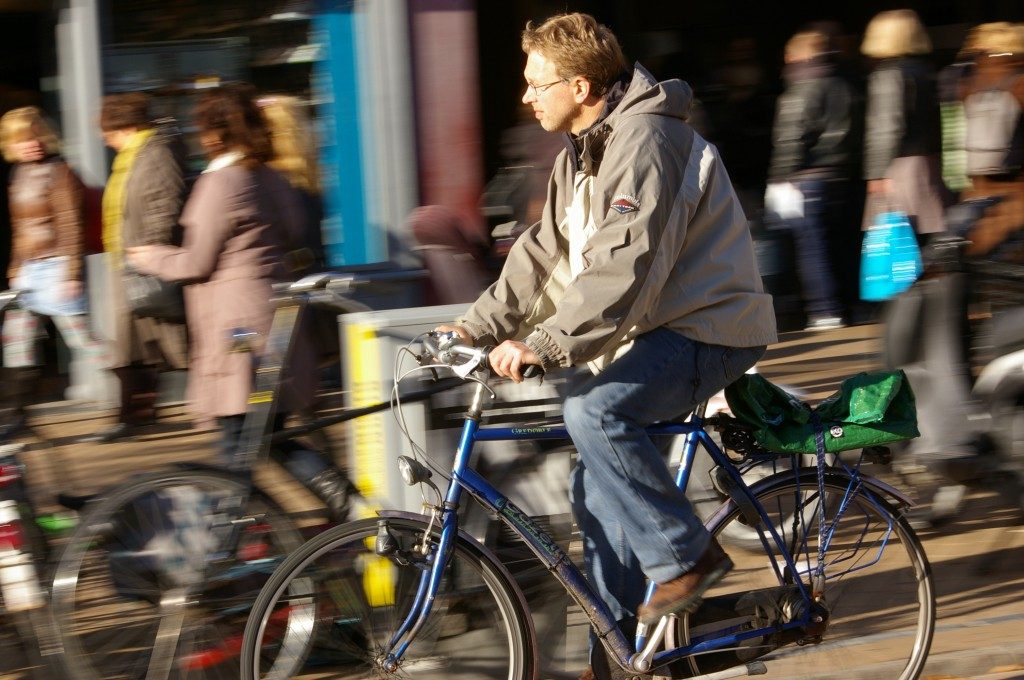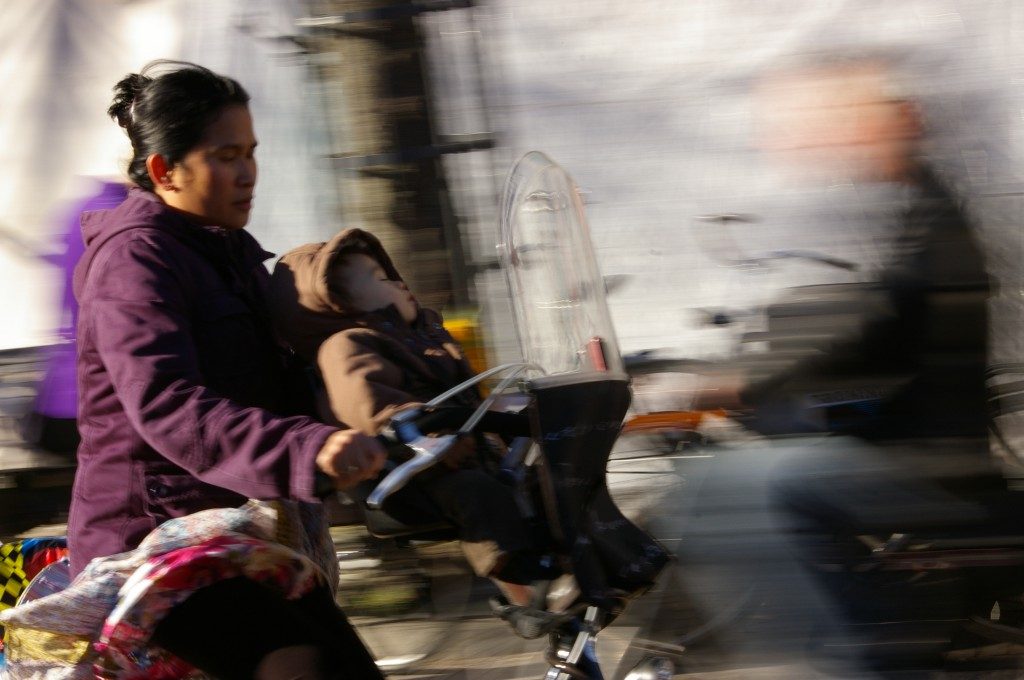The Dutch and their bicycles
I’ve pointed out before that one of the things I like about the Dutch is that they ride bicycles. And it’s not just that it’s politically correct, non-polluting, and good exercise. I’ve lived here for 15 years, and the way the Dutch use their bicycles never ceases to amaze me.
For example, to the Dutch it doesn’t matter at all what the weather is. If it’s pouring rain, that’s okay. They put on terribly unflattering rain clothes, including rainpants, and go right ahead as usual. A really impressive sight is when they carry an umbrella as they ride. I’ve tried that, and, believe me, it’s not easy! You have to steer with one hand while you hold the umbrella tipped forward just exactly at the right angle to keep the rain off you, but not to catch the wind and be pulled back over your head and out of your hand. But if you tip it too far down in front of you as you pedal into the wind, you can’t see ahead of you.
Did a layer of snow collect during the night? Just ride right through it. The city council generally salts the main bike paths, so it’s just a matter of risking the snow (and the ice under it) until you get to a main road. No problem. And, if it’s snowing, the Dutch might even go so far as to put on a hat and gloves: generally the scarf appears when temperatures first dip, but it has to be below freezing to get Dutch people to put on a hat and gloves.
A flock of bicycles
There’s huge variety in the bikes they ride too. Mostly they’re the old-fashioned style, with handlebars higher than the seat so that you can sit up straight while you ride. Generally only pre-pubescent boys ride mountain bikes (which are pretty useless anyway, given how flat it is here), and racing bikes with low, curved handlebars are only used by long-distance bicycling hobbyists.
But there are all sorts of other bicycle mutations available. People with balance problems can still ride here, on an adult-sized tricycle. If you don’t like to sit up on a tiny bicycle seat, turning your nether regions numb, you can use a “ligfiets,” which loosely translates to a “lying-down bicycle.” You sit in a little seat with a backrest, pedaling with your feet straight ahead. Another permutation of the ligfiets closes in the whole bicycle in a solid bullet-shaped case, made out of fiberglass, I think, painted in bright colors, so only your head and the wheels stick out.
The elderly don’t stop riding just because they’re less agile than they used to be. Their bikes are like traditional women’s bikes, with a low bar, except their low bar is even lower to the ground, so they only have to raise their foot a few inches to step onto the bike. And they have rearview mirrors attached to the handlebars.
What they carry on bikes!
And it’s impressive what Dutch people carry on their bikes. The most common is a child or two: the small ones are carried in a seat attached to the handlebars between the rider’s arms, the larger ones sit behind the rider. They can be sitting in purpose-built child seats, but sometimes they’re just sitting there on the back rack and hanging on. Only the youngest – and only a small proportion of them – wear helmets. But the babies who ride in front do often get a transparent plastic windshield attached to the handlebars. Businessmen in tailored suits have a special holder attached to their rear wheel to carry a briefcase. Parents of small children have a clamp that allows them to carry a stroller as well as the child. Some bikes have a special shelf in front that’s perfect for a crate of beer.
The other day I saw a man carrying a bike on the back of his bike. He was taking up the whole bike path by steering with one hand and holding the second bike above his rear wheel with his other hand, so that it stuck out on both sides behind him. I’ve seen people carrying pieces of furniture on bikes: a bookshelf, for example. They clutch it with one hand to keep it on the rack behind them, and it just sticks out the back. And parents carry newborn babies in those kangaroo bags on their chests.
Multi-tasking on bikes
And then there are all the things they can do while bicycling. Lovers hold hands. Mothers of children who are just learning pedal calmly along next to their child’s bike, with a hand on their child’s back to keep them moving in a straight line. Teenagers type text messages while they cycle with no hands. Smokers smoke. Deaf people sign to each other – and swerve all over the place at the same time since their hands are busy with more important things than steering.
Misbehaving while biking
What they mostly do, though, is break the traffic laws. Every schoolchild here is taught about traffic rules in primary school, and many take a test to prove they know how to behave on a bike. That doesn’t stop almost everyone, though, from completely ignoring the rules of the road.
There is one law here that they’re all aware of: if a car and a bike collide, the car driver is automatically assumed to be at fault unless he can make a very convincing argument otherwise. Bicyclists take this as a get-out-of-jail-free pass. They can do absolutely whatever they want because they know that the car drivers will make every effort not to hit them. (I wonder if that rule would make them feel better as they’re lying in pain in a hospital after a crash: “Damn, this broken leg hurts, but it’s not officially my fault!”)
And they do the craziest things! They cut suddenly across roads in front of moving cars without signaling. They turn onto the road from a side street without so much as a glance. They pedal nonchalantly along pedestrian roads, they ride three or four across (two is the legal limit), they don’t signal, they ride in the dark without working lights, they use the sidewalks, bike paths and roads interchangeably at will.
This all sounds like I don’t like Holland’s bicyclists, but I do. I find their sheer hubris, their self-importance, refreshing. (Not when I’m driving a car, mind you, or when I’m walking down a pedestrian street, but the rest of the time.) It displays this assumption about how the world works that I like: “Bicycles and bicyclists are morally superior to – and far more important than – cars and drivers, so you WILL allow me to pass unencumbered.”
I admire that kind of chutzpah. It’s the same attitude they have about rising water levels in this country that’s largely below sea level, but that’s a blog post for another time…
Here are some other articles you might enjoy:
- Driving, Dutch-style
- The Beauty of a Dutch Commute
- Bicycle Baptism
- Advice for Expats: 12 tips
- Watery Hubris





Glad to walk into your blog today as we are going to be in Amsterdam this March and I was told to be prepared to ride a bike while there. 🙂 Very happy to learn that the old style bikes are popular there as that’s the type I like. It’s hard to find them here in the US. I can never get used to the ones here: I am always worried about hitting that bar when I brake!
Yes, you should definitely rent a bike there. It’s lovely to bike along next to the canals, but watch out for all the other riders (and trams and cars and pedestrians)! Why are the old-style bikes so hard to find there?
Hi, Rachel, popping in to follow up on our Twitter exchange, reading through your posts. Special fondness for this one–I’m in hilly, hilly, sprawling Calgary, Alberta, but we’ve got a huge “Coppenhanize” bike movement happening here, and a thriving movement to make our car-built city bike friendly. Me, I own an awesome bakfiet, in which I’ve carted 140 lbs of kids (3 of ’em–room for 4), a dog, and a day’s worth of food. Its only drawback is that it is indeed Dutch-built, which means heavy as hell and really really tough to bike up our hills. (But you ought to see my quads as a result!)
Our winters here are very long and roads treacherous, and while there are all-season cyclists, I am not one of them. So currently, looking at the foot of snow outside my window, I’m humming, “I want to ride my bike, I want to ride my bike” and counting the days until the next melt.
Look forward to reading more of you.
“Jane”
Thanks for the post! What is Coppenhanize? Is that related to Copenhagen? I can imagine it wouldn’t catch on so easily where it’s both hilly and cold! I’m impressed that you manage that bakfiets with all the kids: I bet they love it though! They should put a bike route inside that big mall there!
Regards,
Rachel
I can’t spell: http://www.copenhagenize.com/ and we’ve got a local version. I don’t think bikes will ever become as ubiquitous here as in Copenhagen — the distances are vast, and did I mention the weather sucks 9 months of the year? — but we’ve really come a long way. And if we can achieve it here, it’s possible in any North American city. (Bike/car-free travel are one of my hobby horses. Forgive me.)
Ah, I see. I haven’t been to North America in four years, but I hear that cycling is gaining ground. I’m curious particularly to see New York City. It strikes me as perfect for encouraging cycling: it’s flat, for the most part, and it’s much too expensive to keep a car there anyway. When we lived in San Francisco back in the 90’s, bicycling was terrifying; drivers simply ignored bikes, which had to ride between the parked cars and the driving lanes. That meant a constant danger of people in parked cars opening their driver side doors without looking first…